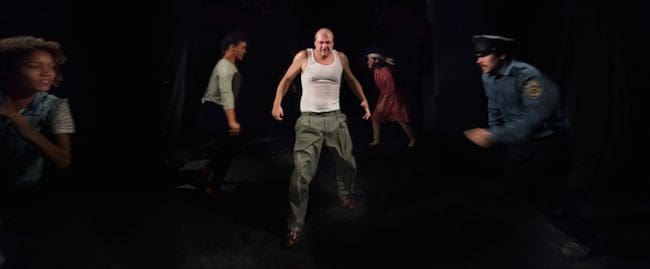Edmond (The Storefront Arts Initiative)
In David Mamet’s bleak one-act Edmond, nearly every actor plays multiple roles. Director Benjamin Blais has his large, diverse cast nearly omnipresent and in perpetual motion, creating a swirling, oppressive crowd through which Tim Walker’s frantic Edmond has to constantly fight to make his way to each of the 23 short encounters that make up the hour-long play. With the exception of Christie Stewart who gives a beautifully felt performance as a waitress with demons and dreams, the effect is a sort of dehumanization of the population of Edmond’s world (though Ryan Tilley’s stirring serenity as a prison chaplain is not to be missed). I mean this as a good thing, it focuses the audience’s attention and strengthens our connection to the title character, played by Walker in a remarkable star turn that infuriates and engages in equal measure. Walker is a naturally sympathetic performer who drags that audience goodwill with him throughout the piece even as he completely disappears into his monstrous character. Thoughtful directorial details such as a cop’s unspoken racial bias and designer Bronwen Lily’s cleverly adaptable set (troublesome sightlines aside) combine with the strong ensemble work to fill out the miserable world that surrounds Edmond but it’s the incredible Tim Walker’s ability to pull us into the depths with him that make Edmond a real thrill.

Hamlet (Hart House Theatre)
This past July, Paolo Santalucia played the title role in a flawed but ultimately very effective production of Hamlet that was so very effective almost entirely because he was particularly brilliant in the role. I was fascinated, then, to see how the insights he brought to the text as an actor might translate when he approached the play from the director’s chair for the production currently on stage at Hart House Theatre. While the summer production was very much a star turn, the Hart House version is much more even, the leading man shining slightly less bright but many of the supporting characters rising to meet him rather than strictly playing second fiddle. Dan Mousseau starts out big as the melancholy Dane, literally falling to his knees as he exclaims “O, that this too too solid flesh would melt[!]” but he evens out as he goes along, finding all his best moments when he speaks from a quieter, more personal place (his “To be or not to be” is mesmerizing, spoken directly to the front row as he sits at the edge of the stage). Sheelagh Daly’s romantic Ophelia is smartly played as depressed rather than “mad” and the casting of fight director Nate Bitton as Laertes pays off in spades. Rather than focusing his performance energy on the character’s superior fight skills, Bitton’s own training allows him to craft a tender portrait of a protective big brother first and foremost, Laertes’ physical strength and swordsmanship coming to him like muscle memory or skills that are a part of the character’s upbringing but not necessarily definitive of his character in a larger sense. The other particularly intriguing piece of casting is Cameron Johnston as Claudius (I’m choosing to ignore his performance as the Ghost because that horrific wig and goatee are too much to bear). There’s an air of sweetness to Johnston that has an interesting effect on Claudius, at times reading as weasely insincerity but at others almost making you sympathize with the murderous king, as though there’s an untold antihero story just on the other side of the classic revenge tale. While the vaguely modern setting (nods at the surveillance state, nods at the class divide; no idea taken quite far enough) and unambitious script cut don’t inspire much, Santalucia’s direction of Hamlet ultimately provides almost as many character insights as his performance of Hamlet did (and also a female Player King, because it’s 2015!). It’s just a very different result because here Hamlet himself isn’t reaping all the benefit.

